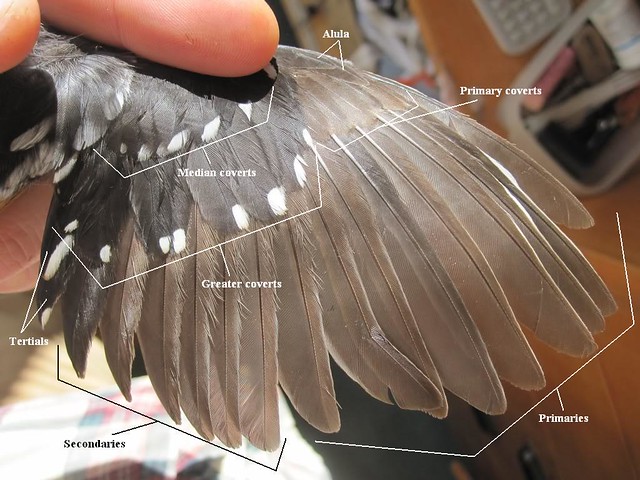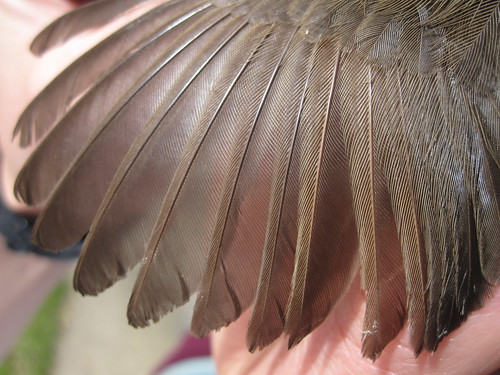
April 30, 2011
House-sitting with Igby
We're house-sitting for Diana again this weekend and took Igby for a ride to Palo this evening. He really wanted shotgun, but I wouldn't let him.


April 27, 2011
Western bluebirds
This pair of Western bluebirds has been around the station for a few weeks now. It's hard to tell if they have fully claimed one of the old cliff swallow nests, but they seem to be staking them out, and chasing off swallows when they get near.
Female

Male

Pair

Female

Male

Pair

April 25, 2011
April 21, 2011
A pair of Golden-Crowned Kinglets
April 20, 2011
Chickadee nest
We have a few nest boxes around the station which we check the contents of every Wednesday. Only one of the boxes has a nest in it, but it's a good one. A pair of chestnut-backed chickadees have created a comfy little nest out of mostly moss, finishing it off with a top inch or two Maria's hair (which was cut and left outside, but slowly disappeared). Last week there were two eggs, but no sign of the parents. This week there are six eggs, and the female didn't hop off the nest until we opened it, despite our knocking on the door before entering.
Contents

Nest and mirror above the nest showing the contents

Contents

Nest and mirror above the nest showing the contents

April 18, 2011
April 16, 2011
April 12, 2011
Cider
I woke up from a nap today to find a large gopher snake sunning in on the path

Amanda and I are house/dog sitting for a couple of days. Cider is a 13ish year old gal with the energy of a puppy...she also remembers the one time there was an exciting frog in the hot tub, and now does this every time it is opened:

Amanda and I are house/dog sitting for a couple of days. Cider is a 13ish year old gal with the energy of a puppy...she also remembers the one time there was an exciting frog in the hot tub, and now does this every time it is opened:
Chestnut-backed chickadee
April 10, 2011
Wing morph
I should have done this earlier, but here is a quick look at the basic terms for the different feathers on a bird wing. All passerines have 9 or 10 primaries and most have 6 secondaries and 3 tertials (which are actually just more secondaries with a special name). In this picture of a spotted towhee wing you can see that there are 9 primaries, 6 secondaries, and two visible tertials. The median coverts, the greater coverts, the tertials, the inner most secondary, and one of the primaries have been replaced, and are much blacker and fresh looking. This pattern is very indicative of a second year bird (one that hatched last summer).


Red-shafted Northern Flicker
Today we caught a red-shafted northern flicker at palo! Very exciting for us considering the size of the bird and the slowness of the day. This bird was also a great example of how one can age woodpeckers. Unlike most of the passerines we catch, woodpeckers can often be micro-aged up to after-third-year. The reason for this is that they follow a more drawn out pattern of feather replacement than most of the birds we catch. So, by looking at different tracts of feather and determining which ones are worn and which ones are fresh, we can age the bird accurately.
This particular female was determined to be a third year bird. It hatched two summers ago and retained all of its primary coverts and secondaries (and replaced many other feathers). About a year after hatching (last summer)it then replaced the outer three primary coverts, as well as all but two of the secondaries. The contrast between the thrashed and faded retained juvenile feathers and the replaced, darker and more fresh adult feathers is very apparent in the pictures below.



Amanda processing

This particular female was determined to be a third year bird. It hatched two summers ago and retained all of its primary coverts and secondaries (and replaced many other feathers). About a year after hatching (last summer)it then replaced the outer three primary coverts, as well as all but two of the secondaries. The contrast between the thrashed and faded retained juvenile feathers and the replaced, darker and more fresh adult feathers is very apparent in the pictures below.



Amanda processing

April 9, 2011
April 8, 2011
Walk with Stallcup
Today the interns went out on a walk with Rich Stallcup, one of the long time PRBO employees and current naturalist for the group. Again, like with Steve Howell, it was such a great opportunity for us to just walk around with such a knowledgeable and interested person and hear and see how he approaches bird watching and absorbing the rest of the world around us. We walked a loop at the Five Brooks trail, and one at the Bear Valley visiting center, making it a short day of work for us all, but much gained, in my opinion.

Here's a list of species (53) we saw in the couple of hours with Rich:
American robin, brown headed cowbird, red winged blackbird, western scrubjay, Oregon junco, mallard duck, California quail, hairy woodpecker, steller's jay, American goldfinch, American crow, acorn woodpecker, downy woodpecker, Allen's hummingbird, tree swallow, sharp shinned hawk, brewer's blackbird, chestnut backed chickadee, ruby crowned kinglet, black phoebe, great blue heron, American wigeon, pie billed grebe, osprey, spotted towhee, purple finch, double crested cormorant, song sparrow, wrentit, pine siskin, Wilson's warbler, band tailed pigeon, pacific wren, pygmy nuthatch, pacific slope flycatcher, brown creeper, turkey vulture, piliated woodpecker, California towhee, red tailed hawk, white tailed kite, violet green swallow, common raven, Nuttall's woodpecker, varied thrush, golden crowned kinglet, oak titmouse, bushtit, warbling vireo, yellow rumped warbler, golden crowned sparrow and red shouldered hawk.

Here's a list of species (53) we saw in the couple of hours with Rich:
American robin, brown headed cowbird, red winged blackbird, western scrubjay, Oregon junco, mallard duck, California quail, hairy woodpecker, steller's jay, American goldfinch, American crow, acorn woodpecker, downy woodpecker, Allen's hummingbird, tree swallow, sharp shinned hawk, brewer's blackbird, chestnut backed chickadee, ruby crowned kinglet, black phoebe, great blue heron, American wigeon, pie billed grebe, osprey, spotted towhee, purple finch, double crested cormorant, song sparrow, wrentit, pine siskin, Wilson's warbler, band tailed pigeon, pacific wren, pygmy nuthatch, pacific slope flycatcher, brown creeper, turkey vulture, piliated woodpecker, California towhee, red tailed hawk, white tailed kite, violet green swallow, common raven, Nuttall's woodpecker, varied thrush, golden crowned kinglet, oak titmouse, bushtit, warbling vireo, yellow rumped warbler, golden crowned sparrow and red shouldered hawk.
April 7, 2011
Groundhog Day
Fort the THIRD day in a row we have done the same thing: Cara and I opened at Palo, Maria, Amanda, and Renee headed to Pine Gulch, we were each open for about 3 hours, and then had to close because of wind. We each caught a few birds, but it's time to change things up this weekend.
Oregon Junco, male

Oregon Junco, female

Oregon Junco, male

Oregon Junco, female

April 2, 2011
Wrentit molt
So, usually wrentits will replace all of their feathers during their first molt in the late summer of their hatch year, but the one we caught today seemed to have retained a few, something we rarely see.
Right wing, with one retained secondary (light brown compared to gray)

Left wing, with three retained secondaries

Right wing, with one retained secondary (light brown compared to gray)

Left wing, with three retained secondaries

April 1, 2011
PRANK
Good day at MUHO today, 10 birds and lots of practice with song sparrows. Some cool birds too.
Downy woodpecker

Chestnut backed chickadee

Wilson's warbler


Downy woodpecker

Chestnut backed chickadee

Wilson's warbler


Subscribe to:
Posts (Atom)













